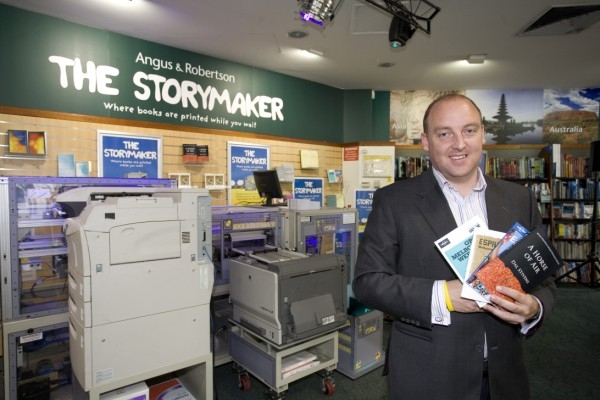
Book retailer Angus and Robertson unveiled the Espresso Book Machine (EBM) at its Bourke Street store in Melbourne last month, saying that the machine would also be rolled out in 50 of its stores across Australia, with the technology geared towards enabling customers to find rare or out-of-print titles.
With the EBM essentially offering print-on-demand – or, as it’s known in some circles, ‘print/book of one’ – there is some debate that printers and publishers now face the same problems as the music, movie and television industries have faced with digital downloads.
However, Michael Schulz from SOS Print, which handles digital printing for prominent book publisher Random House Australia (including ‘print of one’), says the technology still has a long way to go.
Whilst Schulz acknowledges that the EBM does amount to “new competition” for printers like SOS, he also believes that the more sophisticated technology at the hands of major printers still gives them the edge.
“We are hoping that [the EBM] stays in a different league”, said Schulz. “We do higher quality books here, we do high-quality covers, we use cello-glazing and so on.”
“It [the EBM] is running on a little laser printer; our printer is a million dollar machine.”
“The technology is not, and will not be for a very long time, comparable.”
“The other question is: will publishers trust a machine like that? Publishers are very finicky about covers and colours and print quality. It’s very hard to reproduce the kind of quality that we offer.”
The main issue at stake, in Schulz’s opinion, is copyright. Schulz points out that there is currently a dearth of titles available through the EBM, which is mainly due to the fact that publishers are forced to re-negotiate intellectual property red tape in order to make a title available on the EBM.
As for whether the technology will have much of a future beyond the obvious novelty appeal, Schulz concedes that “version 3 might”.
“It makes sense to print books on demand. We all have to look at the changing model of print.”
Schulz says that whilst the issue of cutting out the middleman with machines like the EBM is similar to how music companies have been impacted by digital downloads, the printing industry isn’t under quite the same threat as long as the quality of print-on-demand books lags behind their longer-run counterparts.
“The quality of a downloaded printed book compared to a downloaded MP3 is much lower.”
“With music you can produce or download and sell and distribute high quality music from your home, but whilst the quality with e-books is there, with printed books it’s not.”
Schulz admits, however, that whilst it may not be a problem for the printing industry now, “if we don’t keep an eye on it, it will be.”
Meanwhile, Angus and Robertson has reported that the customer response so far to the technology has been “very, very good”,
“Some people are coming into the store because they’re interested in the technology, they want to have a play around with it,” said company spokesperson Lauren Thomson. “Some are coming in to find a book they haven’t found anywhere else.”
The company hasn’t been able to deploy the technology in any more of its stores as yet, but is still pushing ahead with plans to do so.
“We’ve had a lot of calls from outside Melbourne, people asking ‘when is it coming to Canberra?’ or ‘when is it coming to Townsville?’”
“There will be a focus on regional stores [when more are deployed]. Typically those stores are smaller and have a more limited range, so they can benefit more from the technology.”
Comment below to have your say on this story.
If you have a news story or tip-off, get in touch at editorial@sprinter.com.au.
Sign up to the Sprinter newsletter

